
Understanding Synthetic Data in Self-Supervised Learning (SSL)
What is Self-Supervised Learning (SSL)?
Self-Supervised Learning (SSL) is a branch of machine learning where models learn from unlabeled data by creating pseudo-labels.
This technique reduces dependency on manual annotations, saving time and money. SSL has become essential in tasks like image recognition and natural language processing.
Instead of using large annotated datasets, SSL extracts patterns from unlabeled data, mimicking how humans learn from observation.
Defining Synthetic Data
Synthetic data is artificially generated information that resembles real-world data. It can be text, images, videos, or other formats, created using simulations or generative models like GANs (Generative Adversarial Networks).
This data bridges gaps where real-world data is scarce, enabling the testing and training of AI systems in a controlled manner.
Why Pair SSL and Synthetic Data?
Combining SSL and synthetic data addresses several challenges in AI:
- Overcoming data privacy restrictions by replacing sensitive data.
- Simulating scenarios too complex or costly to replicate in real life.
- Expanding the dataset variety, which strengthens the model’s generalization abilities.
Together, they form a potent duo for scaling machine learning systems.
Benefits of Using Synthetic Data in SSL
Enhanced Data Availability
One of the standout benefits of synthetic data is its availability. In fields like healthcare, gathering real patient data is a logistical and ethical hurdle. Synthetic data fills this void by creating realistic yet non-identifiable substitutes.
SSL, fueled by this surplus, learns without manual intervention, making it ideal for large-scale tasks like autonomous driving or robotics.
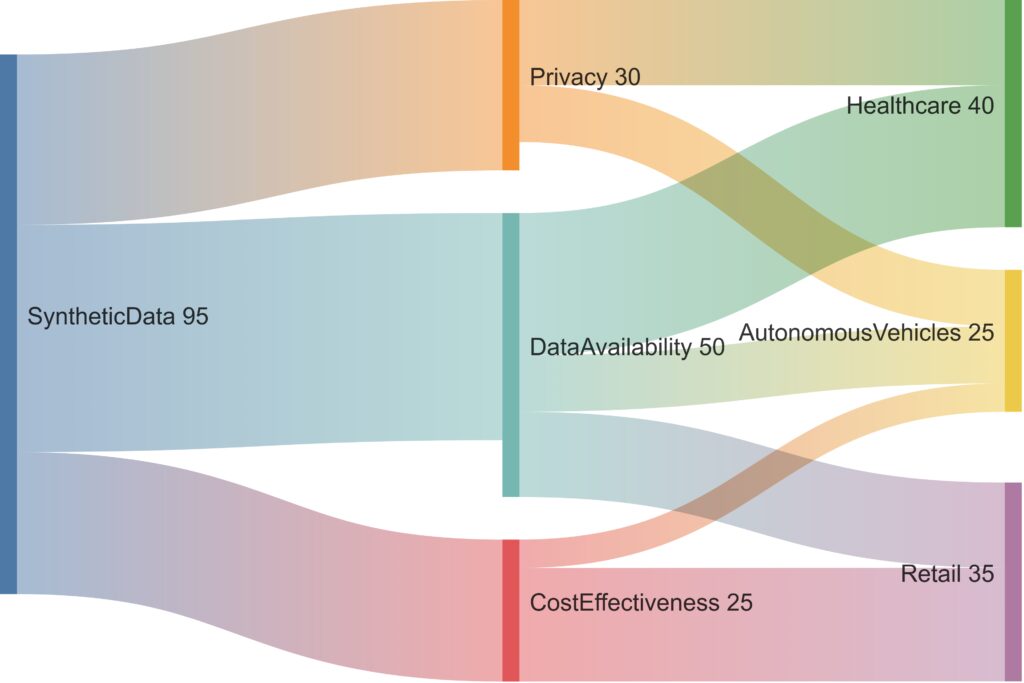
Cost-Effective Data Generation
Traditional data collection is expensive, requiring extensive effort to label and curate. Synthetic data slashes these costs. Tools like Unity, Blender, or simulation platforms allow you to programmatically generate vast datasets.
Additionally, this data can be tailored precisely to model needs, eliminating irrelevant or redundant features.
Privacy and Security Advantages
Privacy laws such as GDPR and HIPAA often limit how real-world data can be used. Synthetic data sidesteps these issues by being inherently non-identifiable.
This makes it a game-changer for industries managing sensitive data, such as finance or healthcare, where security is critical.
Challenges of Synthetic Data in SSL

Limited Realism in Complex Scenarios
Despite advancements, synthetic data struggles to replicate the nuanced complexity of real-world data. For instance, slight inaccuracies in lighting or texture in synthetic images can mislead SSL models.
Models trained solely on synthetic data may underperform in real-world environments, leading to reduced reliability.
Computational Resource Requirements
Generating synthetic data at scale often demands high computational power. Creating hyper-realistic environments involves advanced rendering techniques, which can be resource-intensive and slow.
This increases the barrier to entry for smaller organizations or those with tight budgets.
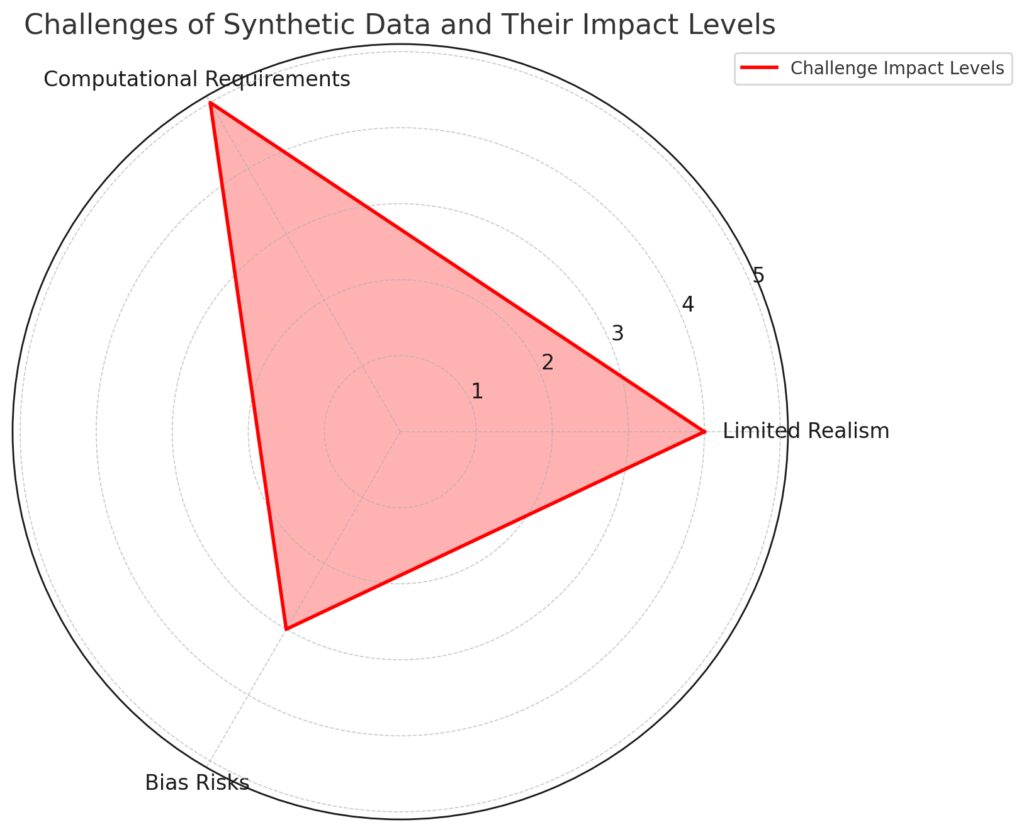
Key challenges of synthetic data generation and their varying impact levels on SSL performance.
Bias Risks and Overfitting
Synthetic datasets are only as unbiased as the humans or algorithms generating them. If the data creator introduces subtle biases, models trained on it could reinforce those biases. This undermines the fairness and accuracy of the SSL system.
Moreover, overfitting to synthetic patterns can occur, especially if real-world validation data is scarce.
Real-World Applications of SSL with Synthetic Data
Autonomous Vehicles
Self-driving cars rely heavily on synthetic data to simulate driving conditions. From bad weather to heavy traffic, synthetic environments prepare models for edge cases that might not exist in collected datasets.
SSL learns from this generated data to recognize objects like pedestrians or road signs without needing labeled examples.
Healthcare Diagnostics
In radiology, synthetic data generates diverse medical imaging datasets. SSL then identifies patterns, such as tumors or fractures, improving diagnostic accuracy while safeguarding patient privacy.
This application is particularly transformative in under-resourced regions where labeled medical datasets are hard to obtain.
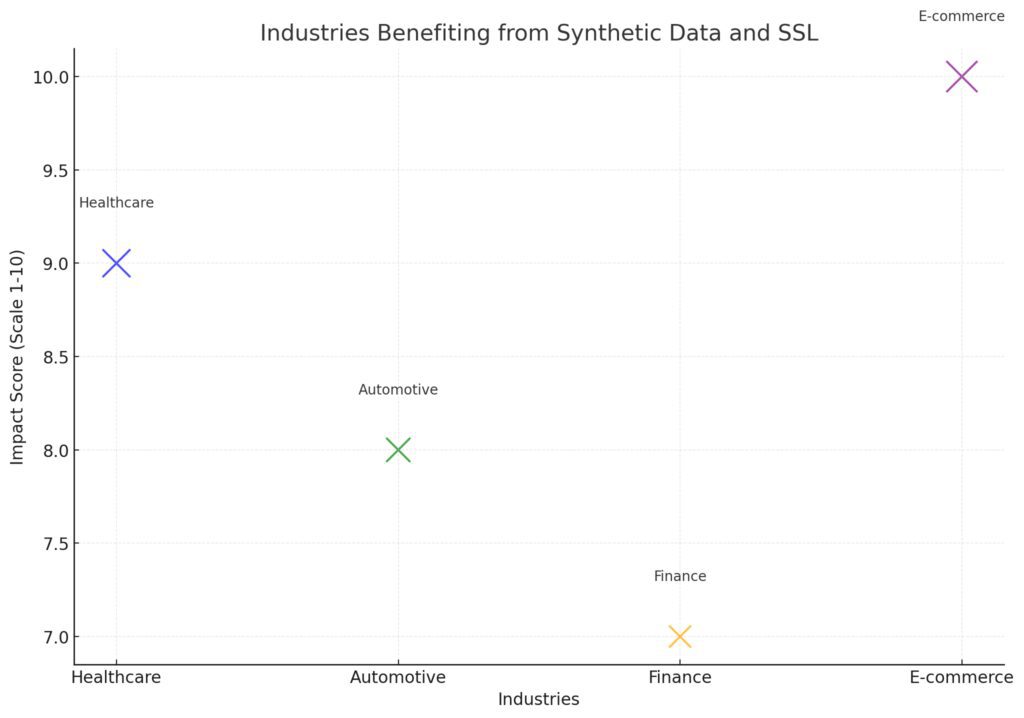
This visualization highlights the varied levels of adoption and impact across industries.
X-axis: Industries (Healthcare, Automotive, Finance, E-commerce).Y-axis: Impact scores on a scale of 1-10, indicating the significance of benefits.
Fraud Detection in Finance
Fraudulent activity often comes in patterns too rare to capture with real-world examples alone. Synthetic data simulates these scenarios, feeding SSL models that learn to spot anomalies.
This leads to more robust financial systems, capable of detecting even novel fraud tactics.
Diving Deeper into Synthetic Data for SSL

How Synthetic Data is Generated
Creating synthetic data requires robust techniques to ensure it closely mimics real-world conditions. Here are a few popular methods used across industries:
1. Simulation Tools
Platforms like Unity and Unreal Engine are employed to create virtual worlds. For example, self-driving car companies generate lifelike traffic scenarios using these tools. Developers can control every variable, from lighting conditions to object behaviors, ensuring comprehensive training datasets.
2. Generative Adversarial Networks (GANs)
GANs are a cutting-edge approach where two neural networks work in tandem: one generates data, while the other critiques it. Over time, this iterative process creates hyper-realistic synthetic data, such as images, videos, or even text. GANs are widely used in tasks like face generation or medical imaging.
3. Data Augmentation
This simpler method modifies existing data to create synthetic variations. Techniques include rotation, cropping, or adding noise to images, as well as paraphrasing or token shuffling in text data. It enhances model robustness without requiring entirely new datasets.
Addressing Bias in Synthetic Data for SSL
Why Bias Emerges in Synthetic Data
Bias can sneak into synthetic data due to flawed assumptions in its creation. For example, if a GAN trained to generate faces uses a predominantly light-skinned dataset, the resulting synthetic faces will reflect this imbalance.
Similarly, simulation tools may inadvertently focus on certain edge cases while neglecting others, leading to skewed model performance in real-world applications.
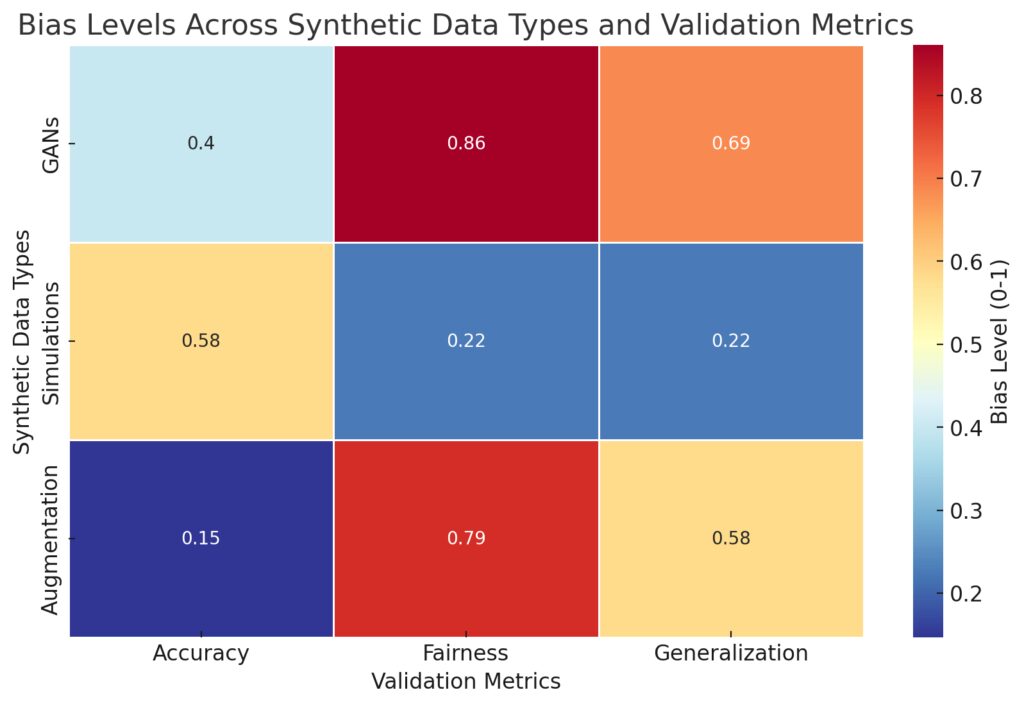
GANs: May exhibit moderate bias levels across fairness and generalization metrics, depending on training data quality.
Simulations: Tend to have lower bias in accuracy but can show higher bias in fairness due to modeled assumptions.
Augmentation: Often achieves balanced generalization but may carry over inherent biases from the original data.
Mitigating Bias Risks
- Diverse Training Inputs
Ensure the models generating synthetic data are trained on datasets representing diverse demographics, scenarios, and conditions. This minimizes the risk of homogenized outputs. - Continuous Validation
Pair synthetic datasets with real-world validation data. Regular testing against real-world benchmarks ensures models don’t overfit to synthetic peculiarities. - Transparency in Data Creation
Document how synthetic datasets are created, highlighting any assumptions made. Open datasets and collaborative audits can help identify and rectify potential biases early.
Emerging Applications of SSL with Synthetic Data

Smart Cities and IoT
In smart city planning, synthetic data simulates urban environments for traffic flow analysis, public safety, and energy optimization. SSL processes this data to predict congestion patterns, optimize public transport, or improve emergency response systems.
Example:
Synthetic datasets generated from IoT devices help SSL models predict sensor failures, enhancing the reliability of interconnected city infrastructure.
Retail and E-Commerce
Retailers use synthetic data to simulate customer behaviors. SSL models analyze this data to optimize pricing strategies, personalize recommendations, or predict inventory needs.
Example:
Virtual shopping environments generated through synthetic data provide endless scenarios for training chatbots or product recommendation engines.
Space Exploration
Synthetic data is vital in preparing machine learning models for space missions. From simulating the Martian surface to creating star maps, SSL learns to navigate unknown terrains without risking costly missions.
Example:
NASA employs synthetic data to train SSL models for autonomous navigation and anomaly detection in rovers.
Combining Synthetic Data and SSL with Other Technologies

Reinforcement Learning and Synthetic Data
Synthetic data complements Reinforcement Learning (RL), where agents learn by interacting with simulated environments. For instance, synthetic traffic simulations help RL agents develop driving policies that seamlessly integrate with SSL object recognition capabilities.
Federated Learning for Privacy-Preserving SSL
Combining synthetic data with Federated Learning strengthens privacy. Synthetic datasets train decentralized SSL models, enabling insights without centralizing real-world data.
This hybrid approach is gaining traction in industries like healthcare, where patient privacy is paramount.
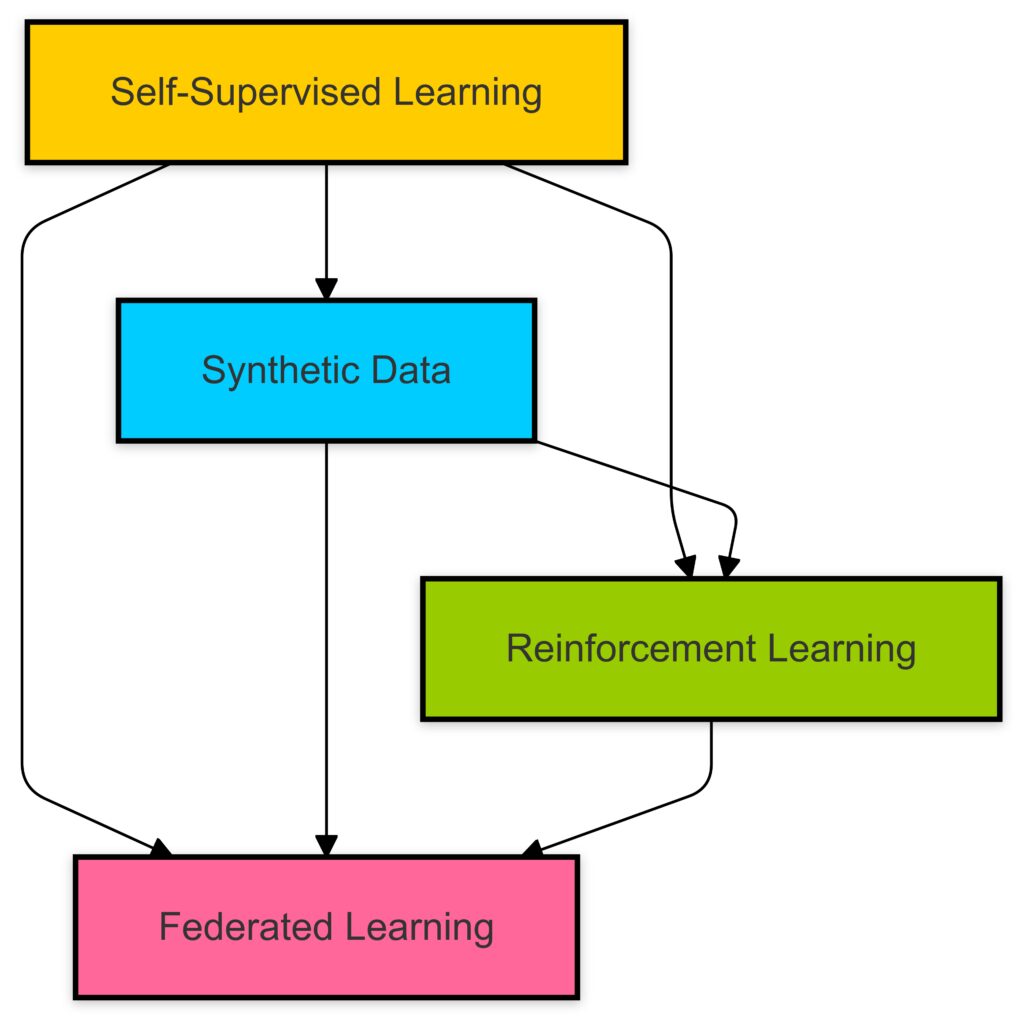
This showcases the synergy between these technologies and their collaborative roles in advancing AI solutions.
Best Practices for Using Synthetic Data in SSL
Aligning Synthetic Data with Real-World Goals
Synthetic data should complement, not replace, real-world data. Always ensure that synthetic datasets reflect the challenges your models will face in deployment. Test models against real-world benchmarks to confirm applicability.
Balance Synthetic and Real Data
While synthetic data expands training possibilities, blending it with real-world data improves reliability. For example, using real data for validation ensures that models don’t overfit to synthetic quirks or biases.
Invest in Robust Generation Techniques
Choose tools and frameworks that suit your domain’s complexity. Platforms like Unity, GAN-based models, or augmented reality simulators should align with your needs. Simpler tasks may thrive on basic augmentation, while sophisticated goals demand high-fidelity synthetic environments.
Monitor and Mitigate Bias Continuously
Bias in synthetic data can inadvertently skew SSL performance. Regular audits of datasets, paired with diverse real-world validation, help identify and address this issue.
Looking Ahead: Tools and Platforms for Synthetic Data Generation
Popular Tools for Synthetic Data
- Unity and Unreal Engine: Ideal for creating high-fidelity, simulated environments for tasks like autonomous driving or robotics.
- NVIDIA Omniverse: A collaborative platform for designing and simulating synthetic datasets, particularly in 3D applications.
- GPT-Synthetic Data Generators: Leveraging large language models to create synthetic text data for NLP applications.
- Synthia: Tailored for autonomous driving, this tool creates diverse driving scenarios for robust model training.
Open Datasets for Synthetic Data
Explore publicly available synthetic datasets like:
- CARLA Simulator: A popular dataset for autonomous driving research.
- Librispeech Synthetic Dataset: Useful for speech-to-text and audio analysis models.
The Future of Synthetic Data in SSL
The synergy between synthetic data and SSL will continue reshaping AI. As generation techniques improve, we can expect increasingly realistic datasets, accelerating innovation across industries like healthcare, e-commerce, and space exploration.
FAQs
Comparing Synthetic Data vs. Augmented Data
| Aspect | Synthetic Data | Augmented Data |
|---|---|---|
| Generation Method | 🛠️ Created from scratch using models like GANs or simulations. | 🌀 Derived from existing data by applying transformations. |
| Data Source | 🔧 Independent of original datasets, fully artificial. | 🔄 Requires a real dataset as a base. |
| Scalability | 🚀 Highly scalable for creating large, diverse datasets. | 🔄 Limited by the size and diversity of the original dataset. |
| Typical Use Cases | 🧠 Training AI models in rare scenarios, privacy-preserving tasks. | 📈 Enhancing existing datasets for robustness or minor tweaks. |
| Bias Handling | ⚖️ Can mitigate biases if properly designed. | ⚠️ May propagate biases from original data. |
| Privacy | 🔒 Preserves privacy by design; no direct link to real data. | ⚠️ Privacy risk if source data is sensitive or identifiable. |
| Complexity of Creation | 🌐 Requires sophisticated tools like GANs, variational autoencoders. | 🌀 Easier to implement with basic transformations. |
How can bias in synthetic data be avoided?
Bias mitigation involves diversifying training inputs, testing models against real-world benchmarks, and maintaining transparency about assumptions in the data generation process. Regular audits further reduce bias risks.
What role does GAN play in synthetic data?
Generative Adversarial Networks (GANs) are pivotal for creating realistic synthetic data. They generate data iteratively, refining quality through competition between the generator and discriminator networks.
Is synthetic data generation resource-intensive?
Yes, especially for high-fidelity environments or complex simulations. While tools like GANs can be computationally expensive, simpler methods like data augmentation are more accessible and efficient for basic tasks.
Is synthetic data legally compliant with privacy regulations?
Yes, synthetic data can bypass privacy concerns because it doesn’t contain identifiable real-world information. This makes it especially valuable in fields governed by strict regulations like GDPR and HIPAA.
How does SSL improve when paired with synthetic data?
SSL thrives on large, unlabeled datasets, and synthetic data offers exactly that. By generating diverse and controlled datasets, synthetic data enhances the variety and complexity of patterns SSL models can learn from, resulting in improved performance and generalization.
Can synthetic data help with rare-event modeling?
Absolutely. Rare events, like natural disasters or fraud detection, are difficult to capture in real-world datasets. Synthetic data allows for the creation of these scenarios at scale, enabling SSL models to learn effectively.
What are some challenges of using synthetic data for SSL?
Challenges include ensuring realism in data generation, avoiding overfitting to synthetic patterns, and managing the computational costs of creating high-quality datasets. Additionally, the quality of synthetic data directly impacts model accuracy.
How is synthetic data validated for real-world applicability?
Validation involves comparing model performance on synthetic data with real-world datasets. By testing the model in real scenarios, developers can identify gaps and refine the synthetic dataset to better align with practical conditions.
Can synthetic data reduce the cost of AI development?
Yes, significantly. Synthetic data eliminates the need for expensive manual labeling and accelerates the training process by providing large, ready-to-use datasets. This cost efficiency is especially beneficial for startups and research projects.
Are there ethical concerns in using synthetic data?
While synthetic data addresses many ethical concerns, like privacy violations, it can introduce new issues if it inadvertently embeds biases. Transparency and rigorous validation are essential to maintain ethical standards.
What’s the difference between synthetic data and augmented data?
Synthetic data is entirely generated (e.g., by simulations or GANs), while augmented data modifies existing datasets (e.g., by rotating or cropping images). Both enhance datasets but serve different purposes in AI training.
What’s the future of synthetic data in machine learning?
The future looks promising as synthetic data generation becomes more sophisticated. With advancements in tools like GANs and simulation platforms, industries will increasingly rely on synthetic data for cost-effective, scalable, and privacy-preserving AI development.
Resources
Open-Source Tools for Synthetic Data Generation
- CARLA Simulator: A leading open-source platform for generating synthetic data for autonomous vehicle research. Learn more here.
- NVIDIA Omniverse: A robust tool for creating 3D simulations across industries, including robotics and design. Explore NVIDIA Omniverse.
- Blender: A free and open-source 3D modeling and simulation tool, widely used for synthetic data generation in visual tasks. Visit Blender.
- Synthia Dataset: A dataset generator tailored for urban driving scenarios, ideal for machine learning in autonomous systems. Check Synthia here.
Platforms for GAN-Based Data Creation
- TensorFlow-GAN: A library for building and training GAN models. Excellent for generating synthetic text, images, or audio. Explore TensorFlow-GAN.
- PyTorch Lightning: Simplifies building GANs and other models with flexible pipelines. Learn about PyTorch Lightning.
- RunwayML: A user-friendly platform for generating GAN-based synthetic data without deep technical expertise. Visit RunwayML.
- Industry-Ready Tools and Services
- Datagen: Offers custom synthetic data solutions for vision-based applications. Learn about Datagen.
- Mostly AI: Specializes in synthetic data for finance and healthcare, ensuring privacy compliance. Check Mostly AI.
- Parallel Domain: A platform for creating high-quality synthetic data for robotics and autonomous systems. Visit Parallel Domain.



